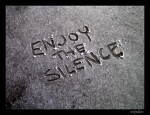The obstacles to becoming an adept yogi are sleep, laziness and disease. One has to remove these by the root and throw them away … Asana will help all this. To acquire this skill, recite the following slokam every day before practicing yoga. –Yoga Makaranda (II.3)
maṇi bhrātphaṇā sahasravighṛtaviśvaṁ
bharā maṇḍalāyānantāya nāgarājāya namaḥ
Salutations to the king of the Nagas,
to the infinite, to the bearer of the mandala,
who spreads out the universe with thousands
of hooded heads, set with blazing, effulgent jewels.
(Listen to Richard Freeman chanting.)
In Patanjali’s Yoga Sutras (I.30) there are nine obstacles to the practice listed.
 Doubt – sanshaya
Doubt – sanshaya
Lacking conviction or confidence, distrust, and fear, are among a few of the definitions of “doubt” that make it pretty clear why it tops the list of Patanjali’s obstacles in the third position. However, the other definition that is found most in tandem with these less positive ones revolves around uncertainty. It is that definition family that gives rise to sentiments like Paul Tillich’s “Doubt isn’t the opposite of faith, it is an element of faith.” Or Volataire’s, “Doubt is an uncomfortable condition, but certainty is a ridiculous one.” Or doubt being one of three great qualities in Buddhism: Great Doubt, Great Faith, and Great Determination.
Doubt is the factor that allows us to drop how and what we’ve pre-decided about people and situations. It grants us freedom to respond to what is, freedom from having to know, freedom not to need to make up our mind about what’s happening right now – to be alive and open to what is.
Two Doubts
Doubt can function in our practice in two ways; one is as a general mood of open inquiry – of a cultivated uncertainty that keeps us awake to the moment. The second is one of critical inquiry that takes a teaching we’ve read or seen and begins to turn it into something we experiment with and experience for ourselves. The results of any teaching reveal its worth.
Stephen Batchelor describes the first kind of doubt in his book, “Confessions of a Buddhist Atheist”;
“When the retreat began and I started meditating in earnest on the question “What is this?” my mind insisted on coming up with clever answers. Each time I tried to discuss my latest theory with Kusan Sunim, he would listen patiently for a while, then give a short laugh and say: “Bopchon [my Korean name]. Do you know what it is? No? Then go back and sit.”
Irrespective of how suitably enigmatic they seemed, my answers were either trite or predictable. After a while, I simply gave up trying to find an answer. “What is this?” is an impossible question: it is designed to short –circuit the brain’s answer-giving habit and leave you in a state of serene puzzlement. This doubt, or “perplexity” as I preferred to call it, then slowly starts to infuse one’s consciousness as a whole. Rather than struggling with the words of the question, one settles into a mood of quiet focused astonishment, in which one simply waits and listens in the pregnant silence that follows the fading of the words.”
We can offer this type of listening to our experiences in nature, in relationship, in our meditation and yoga practices. We can be free from what we think is happening, right in the middle of it happening. Not that we erase our memory, or don’t have ideas, but that we can drop the teacher, you can say to yourself “neti neti” – not this not this, and practice the freedom from knowing.
“Doubting has immense power. It allows us to remain curious and to consider multiple alternative perspectives. This is deeply important because as soon as we think we understand something, we stop paying attention. We then miss the truth about it because nothing is ever as simple as our minds try to make them. Once we think we think we have the answer, we stop questioning. Once we understand something, we grow bored with it.” Sangha member at ID Project
 Rilke writes of the second kind of doubt; “And your doubt can become a good quality if you train it. It must become knowing, it must become criticism. Ask it, whenever it wants to spoil something for you, why something is ugly, demand proofs from it, test it, and you will find it perhaps bewildered and embarrassed, perhaps also protesting. But don’t give in, insist on arguments, and act in this way, attentive and persistent, every single time, and the day will come when, instead of being a destroyer, it will become one of your best workers–perhaps the most intelligent of all the ones that are building your life.”
Rilke writes of the second kind of doubt; “And your doubt can become a good quality if you train it. It must become knowing, it must become criticism. Ask it, whenever it wants to spoil something for you, why something is ugly, demand proofs from it, test it, and you will find it perhaps bewildered and embarrassed, perhaps also protesting. But don’t give in, insist on arguments, and act in this way, attentive and persistent, every single time, and the day will come when, instead of being a destroyer, it will become one of your best workers–perhaps the most intelligent of all the ones that are building your life.”
Here Rilke gives us advice on what to do when doubt arises, as if seemingly on its own. How to allow it to be a harbinger of investigation. While not recommended as how to work in the midst of a meditation or yoga practice, later reflection on doubts that arise from practice or elsewhere would be a powerful way to cultivate great doubt in our lives.
A paper by Robert M Baird on Creative Doubt looks at that second type of doubt from a more proactive lens – to take on the task of actively doubting. The online abstract opens with this story:
“A college student approached his professor after class. With anguish he complained, “I don’t know whether you know it or not, but this class is painful.” “How’s that?” the professor asked. “Well,” the student continued, “you have convinced me that we ought to do what you are encouraging us to do, but when I do what you suggest, it’s so painful.”
What had this professor suggested? What had he encouraged his students to do, the doing of which created, in at least one student, pain? He had encouraged them to doubt creatively. That is, he had encouraged his students to challenge and evaluate the fundamental values – ethical, political, and religious – to which they were committed.”
Follow this source link for further information about the paper, as well as the complete abstract which presents his four arguments for the benefits of creative doubt.
Whether Rilke or Baird, Batchelor, or the Buddha, there is a strong tradition for actively cultivating skillful doubt in our lives. Can you imagine undertaking one of these practices for a month? What happens? What shifts?
Small doubt, small enlightenment; big doubt, big enlightenment – Zen Master Nine Mountains

 1) Savasana – truly use the time to be quiet, still, resting and inwards. Avoid the habit embedded in us since childhood of turning to TV or movies. If you can’t get up, truly be down. Since I was travelling, I did not have my Netflix queue nor my stash of comfort reading. I had no choice but to savasana, and it was delightful.
1) Savasana – truly use the time to be quiet, still, resting and inwards. Avoid the habit embedded in us since childhood of turning to TV or movies. If you can’t get up, truly be down. Since I was travelling, I did not have my Netflix queue nor my stash of comfort reading. I had no choice but to savasana, and it was delightful.






















